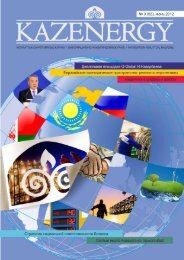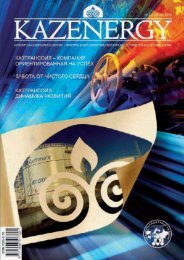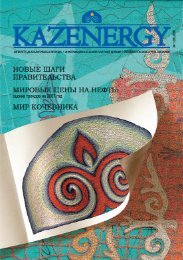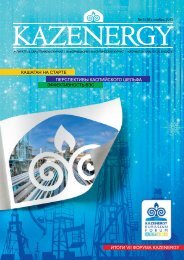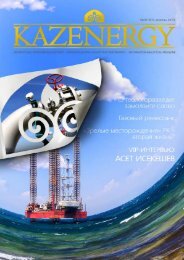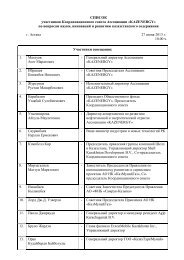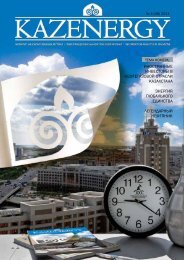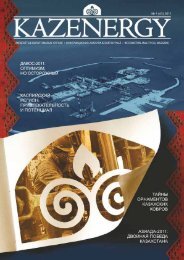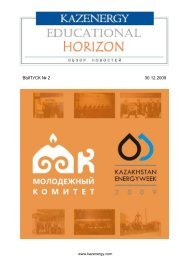â 5 (49), 2011 - KazEnergy
â 5 (49), 2011 - KazEnergy
â 5 (49), 2011 - KazEnergy
- No tags were found...
You also want an ePaper? Increase the reach of your titles
YUMPU automatically turns print PDFs into web optimized ePapers that Google loves.
This year it is a century ago that the first oil operators from Western Europe engagedin Kazakhstan. In 1911, the Nobel family of Sweden, which was already active inAzerbaijan across the Caspian, also obtained a 42.5 percent stake in Emba-Kaspiisky.The same year, the Royal Dutch (now Royal Dutch Shell) made a bid for concessionson adjacent areas to the Russian government. Both companies started working on thefields over the winter. But the deals they struck to get there make <strong>2011</strong> the hundred-yearanniversary of partnerships with western oil companies for Kazakhstan.Facing bankruptcyThe series of shake-ups on the world oil marketsin the early XXth Century, includinga price war against Russian oil producerswaged by Standard's Rockefeller, the internalstrife for control over Baku's foreignheldoil assets between Rothschild, Shell,the Royal Dutch and the Nobel brotherswhich in the end was to leave only the lattertwo present, and finally the uproar causedby the foiled revolution of 1905/'06 did notfail to have its impact on financial marketsin Russia, and the northern Caspian oilbusiness could not escape the effects of theoverall instability.Leading western partners, whose assets inBaku had suffered to limited extents only,were the only ones who could provide thefinancial means to pick up where ventureslike the Emba-Kaspiisky, even though therehad been little sociopolitical unrest on thespot as such, were facing bankruptcy.The ones to save the day were the Europeans.By the end of the decade, along withmajor shares in originally Russian, Armenian,Azeri and Tatar companies in Azerbaijan,the northern Caucasus, the northeasternBlack Sea region and the lower Volgaprovince, the Nobel family had also obtaineda 42.5 percent stake in Emba-Kaspiisky.Ambitious plansHowever, it was not before 1912 thatthey finally started working - virtuallyalongside the Royal Dutch (nowRoyal Dutch Shell) which had obtainedits concessions on adjacentareas years later, and through directdealings with the Russian government."Royal Dutch Shell had beaten Nobel tothe Urals by a few months but by the latesummer of 1912 the Swede Wannebo andthe Russian Kusnezov were organising extensivedrilling and pipe-laying operations,working the Nobel parcels selected by companygeologist Fegraeus," Nobel family biographerRobert Tolf was to relate in his book"The Russian Rockefellers - the saga of theNobel family and the Russian oil industry"published in 1976."In a climate and setting even less hospitableto exploitation than Baku the pipelinewere laid, food and supplies brought in fromAstrakhan and transported by camel to Dossor,”the book relates. “Huge pits were dugand filled with winter snow to provide waterin the summer. Docks were built in Rakushaon the Caspian. As soon as the oil startedflowing refineries were added. The finishedproduct was shipped by barge directly to Astrakhan.Both Nobel and the Royal DutchKAZENERGY57






